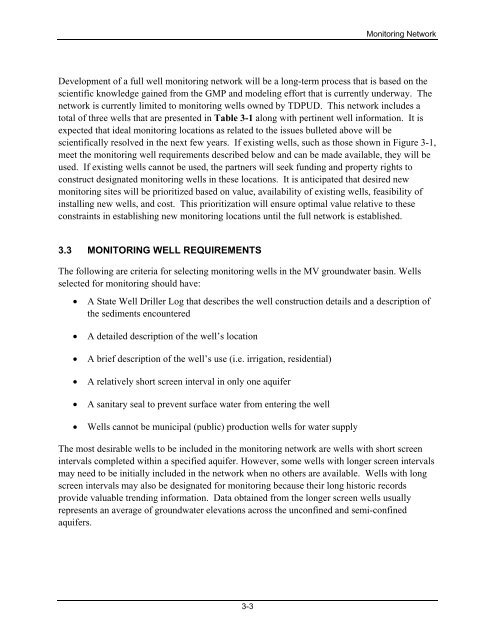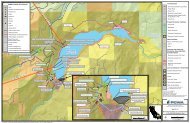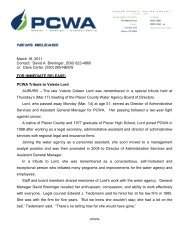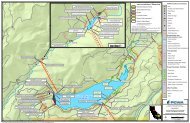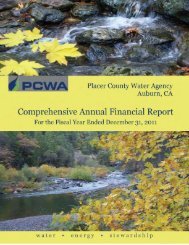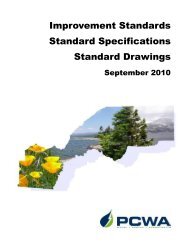Martis Valley Groundwater Management Plan - Placer County Water ...
Martis Valley Groundwater Management Plan - Placer County Water ...
Martis Valley Groundwater Management Plan - Placer County Water ...
You also want an ePaper? Increase the reach of your titles
YUMPU automatically turns print PDFs into web optimized ePapers that Google loves.
3-3<br />
Monitoring Network<br />
Development of a full well monitoring network will be a long-term process that is based on the<br />
scientific knowledge gained from the GMP and modeling effort that is currently underway. The<br />
network is currently limited to monitoring wells owned by TDPUD. This network includes a<br />
total of three wells that are presented in Table 3-1 along with pertinent well information. It is<br />
expected that ideal monitoring locations as related to the issues bulleted above will be<br />
scientifically resolved in the next few years. If existing wells, such as those shown in Figure 3-1,<br />
meet the monitoring well requirements described below and can be made available, they will be<br />
used. If existing wells cannot be used, the partners will seek funding and property rights to<br />
construct designated monitoring wells in these locations. It is anticipated that desired new<br />
monitoring sites will be prioritized based on value, availability of existing wells, feasibility of<br />
installing new wells, and cost. This prioritization will ensure optimal value relative to these<br />
constraints in establishing new monitoring locations until the full network is established.<br />
3.3 MONITORING WELL REQUIREMENTS<br />
The following are criteria for selecting monitoring wells in the MV groundwater basin. Wells<br />
selected for monitoring should have:<br />
A State Well Driller Log that describes the well construction details and a description of<br />
the sediments encountered<br />
A detailed description of the well’s location<br />
A brief description of the well’s use (i.e. irrigation, residential)<br />
A relatively short screen interval in only one aquifer<br />
A sanitary seal to prevent surface water from entering the well<br />
Wells cannot be municipal (public) production wells for water supply<br />
The most desirable wells to be included in the monitoring network are wells with short screen<br />
intervals completed within a specified aquifer. However, some wells with longer screen intervals<br />
may need to be initially included in the network when no others are available. Wells with long<br />
screen intervals may also be designated for monitoring because their long historic records<br />
provide valuable trending information. Data obtained from the longer screen wells usually<br />
represents an average of groundwater elevations across the unconfined and semi-confined<br />
aquifers.


